Project "Iceberg"
 The third of July marks exactly 20 years of the film "Terminator 2". He was remembered not only by high-quality directing and Arnie's generous smile, but also by special effects that were breakthrough for that time. Computer graphics, which was created in the first, not yet fully “dopilennoy” version of Adobe Photoshop, looks good today. Technology has changed dramatically since then, but whether the films themselves have improved is a big question. Now the entertainment industry is actively developing the technology of three-dimensional images: they make films in “three-de”, and now they can even be watched on a laptop screen. The entertainment industry promotes promising developments to the masses. And how effectively can they be used in a few more serious tasks?
The third of July marks exactly 20 years of the film "Terminator 2". He was remembered not only by high-quality directing and Arnie's generous smile, but also by special effects that were breakthrough for that time. Computer graphics, which was created in the first, not yet fully “dopilennoy” version of Adobe Photoshop, looks good today. Technology has changed dramatically since then, but whether the films themselves have improved is a big question. Now the entertainment industry is actively developing the technology of three-dimensional images: they make films in “three-de”, and now they can even be watched on a laptop screen. The entertainment industry promotes promising developments to the masses. And how effectively can they be used in a few more serious tasks?We will talk about such tasks. The picture on the right is not a render, and not a frame from a computer toy. This is the result of serious work on modeling real environmental conditions, taking into account all the smallest details - from the weather at a given latitude to the characteristics of sea water. Antarctic researcher Georges Mougins, together with Dassault Systemes experts, tried to answer a rather complicated question: is it possible to “drag” an iceberg to where severe drinking water shortages are being experienced? I tried to tell you about how they tried to solve this problem with the help of CATIA and SIMULIA solutions.
According to the UN, only 42% of the world's inhabitants have access to clean drinking water. Even in Europe, up to 20% of the population suffer from a lack of water. At the same time, water is the same non-renewable resource as oil or coal, and there is simply no alternative way to extract water. Existing seawater desalination projects have been criticized for quite serious damage to the environment. At the same time, a huge amount of fresh water (68.7% of world reserves) is literally frozen. A part of ice cover in the form of icebergs is constantly dissolved in salty sea water, and it could be used.
')
How? The obvious answer is to drag the iceberg to where the water shortage is particularly acute. It is easy to say, but no one has set up such experiments, preliminary preparation will cost too much. Georges Mougins founded Iceberg Transport International in 1975. Despite the solid financial support of the royal family of Saudi Arabia, Prince Mohammed Al-Faisal, the impudent plan was not realized. In 2009, Mougins met with a representative of Dassault Systemes, who offered to use the technologies and experience of the company's specialists for the experimental transport of an iceberg in virtual reality.

In order to at least slightly limit the amount of source data, it was decided to take an iceberg of a certain size and shape. As an example, a real table-shaped iceberg was used, drifting near the shores of Newfoundland, approximately here . The iceberg parameters are as follows: dimensions 163x236x189 meters, weight 7 million tons. This is enough to provide water for 35,000 people during the year. An iceberg of such a shape is rather stable, so there is less chance of it splitting towards the end of the path. The Canary Islands ( Google Maps ) was chosen as the final point, where there are big problems with drinking water: they actively collect rainwater, desalinate sea water and pump out the last reserves from the ground.
And then, in fact, the most interesting thing began. After determining the shape and size of the iceberg, there are about a million factors left in the task that somehow influence the development of events. How fast does the glacier melt? How fast can you drag it? One tug or ten? And if there is a storm? Under what conditions can it fall apart? And how to fix it, in the end, in the absence of any towing eyes?
Let's start with the method of towing. It was proposed by Georges Mougins and is this:

First, with the help of tugs, an iceberg is surrounded by a floating railing.

So this “fence” looks under water. "Bags" in the lower part of the design is actually another element of the fence, which is still in a collapsed form.
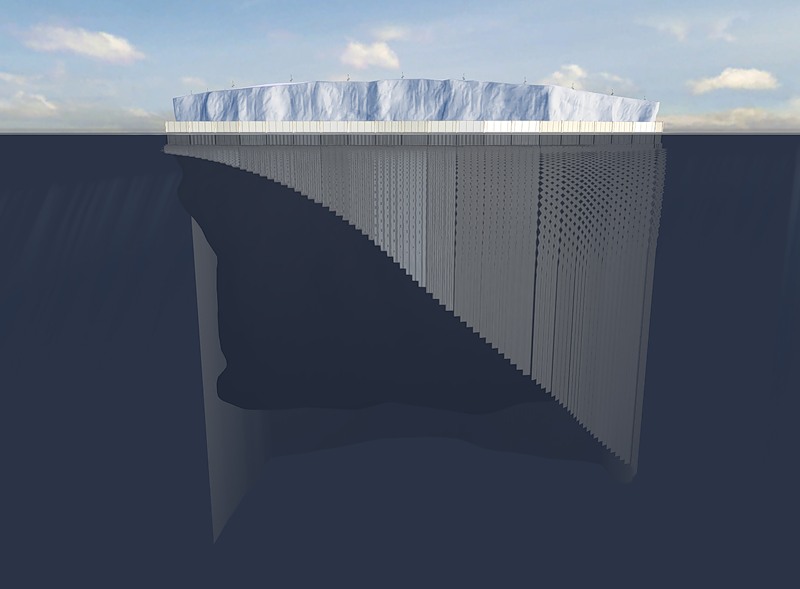
The length of this "skirt" allows you to completely close the underwater part of the iceberg.
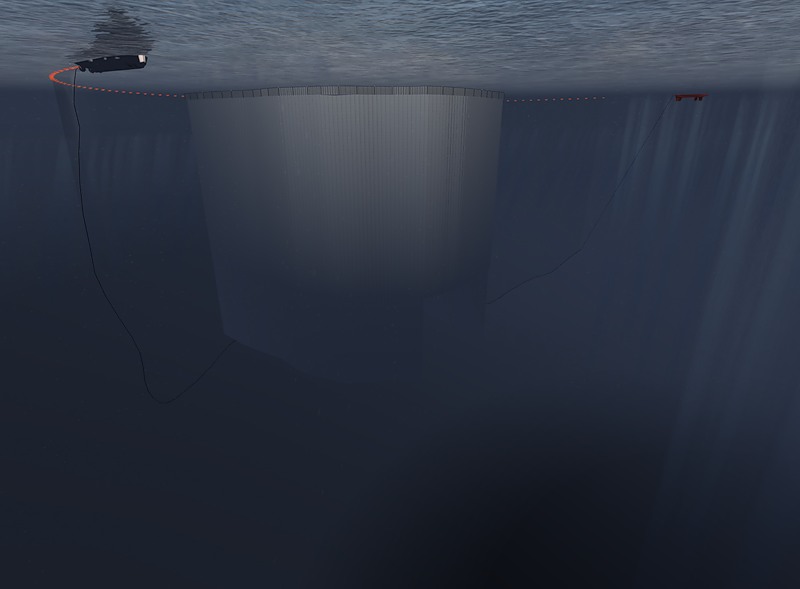
There is another fence, this time in the form of a light but durable grid.
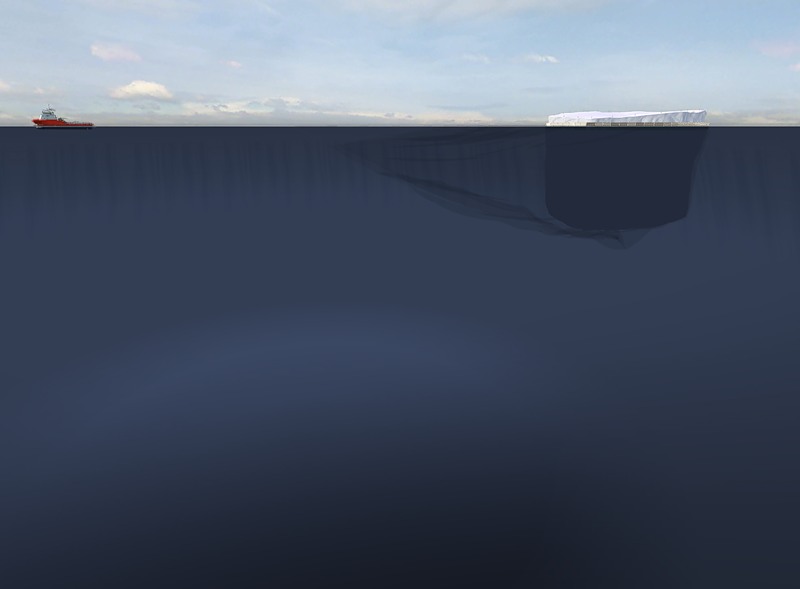
And it is this network that clings to the towing cable. After several experiments, it was found that it is most effective to use a single (albeit very powerful) tug, and to maximize the power of the sea currents to save fuel. True for this, the parameters of currents, water temperature, etc. also had to be added to the "equation". By the way, all these parameters were calculated in the CATIA CAD system, exactly the same as in our previous articles.
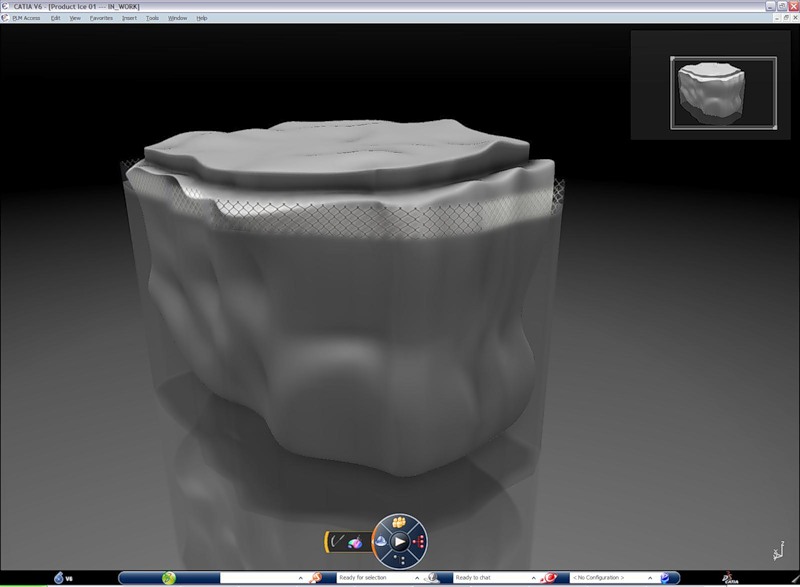
Now, I think, it is clear why Dassault Systemes takes up such projects with interest. This is not just a matter of advertising or responsibility for the environment. Such complex tasks force us to use the maximum capabilities of 3D design and visualization systems. And besides, it's just interesting :)

What you see in the screenshots above are visualization frames from SIMULIA. And this is how the fencing system looks like in CATIA.
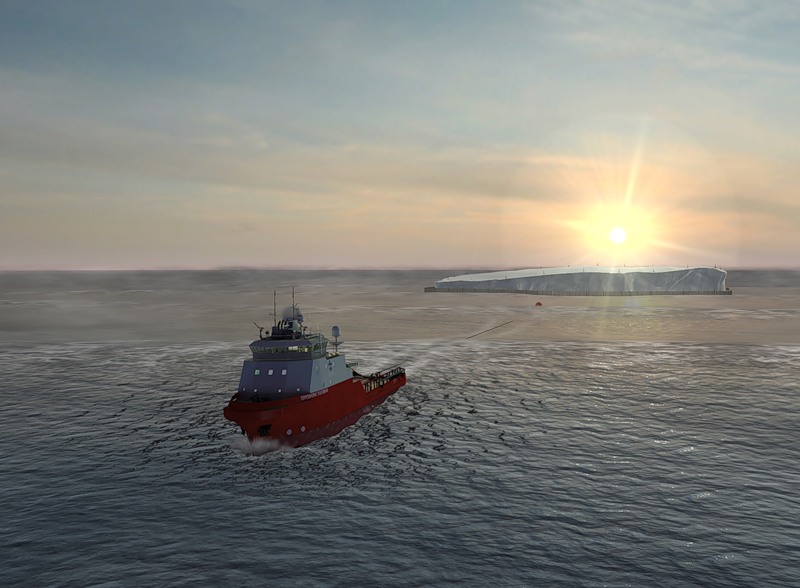
It is also necessary to simulate all natural conditions. The weather - for example, clear, with the sun becoming more and more active as it approached the equator ...

Or a strong storm, testing the strength of the entire transportation system.
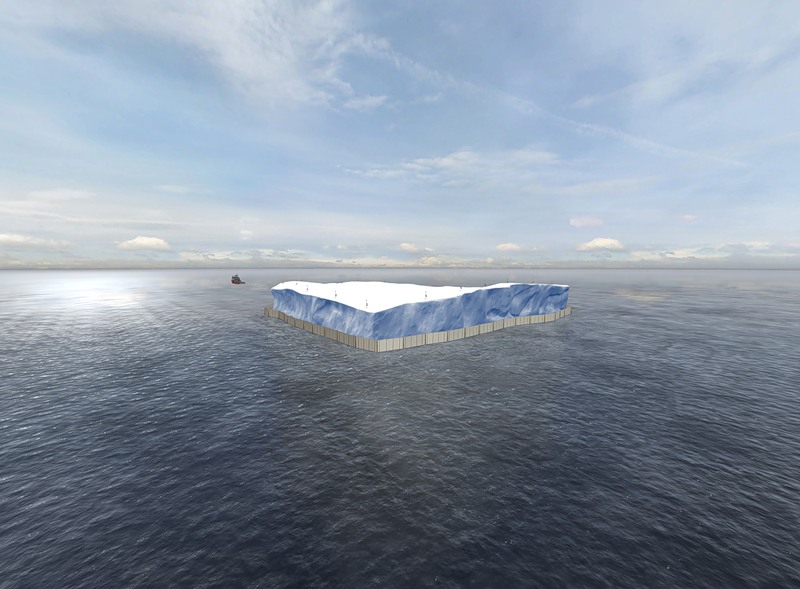
Program climate change as you move south.
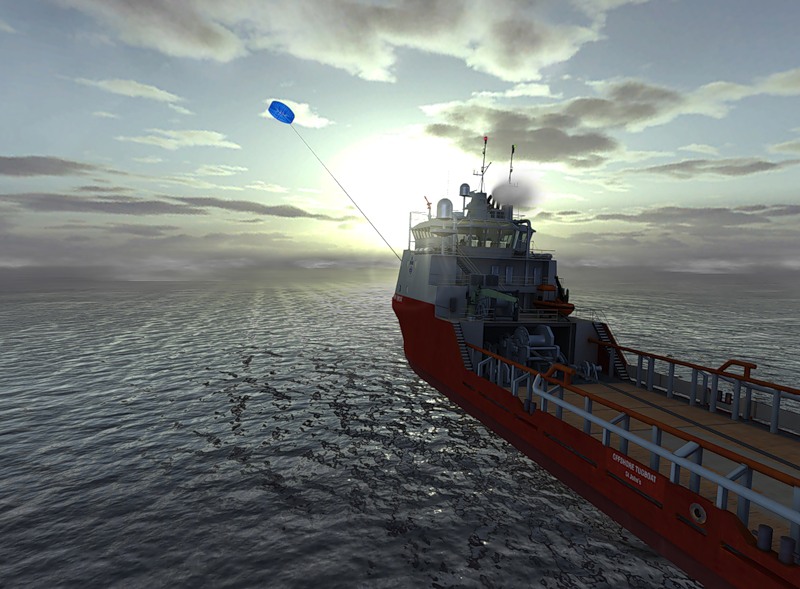
It is even possible to use wind power to save fuel (or time — an iceberg is melting).
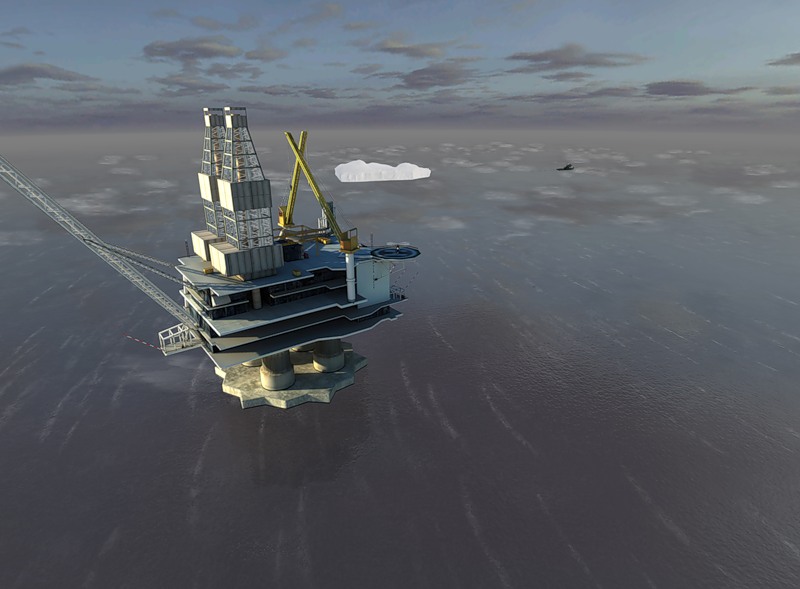
It is assumed that a radar will be installed in tow, which will allow maneuvering and circumventing the obstacle in time. For example - another iceberg. By the way, the construction of the fence protects the iceberg from pollution: if the tug has to go through the oil slick, only the protective dome will suffer.

Well, and so on :)
This is a really difficult and interesting job, but it is only a part of the whole project. For Georges Mougins, the author of the idea and the potential performer, as well as for the potential investors of the project, the final figures are important. How many days will transportation take? How much fuel is needed? What time of year is best? And, most importantly, what part of the iceberg will be able to reach the end point. As a result, engineers at Dassault Systemes improved the computer model of the iceberg to the level of the “captain’s bridge”. It is enough to enter the starting and ending coordinates, and the system automatically calculates all the necessary parameters.
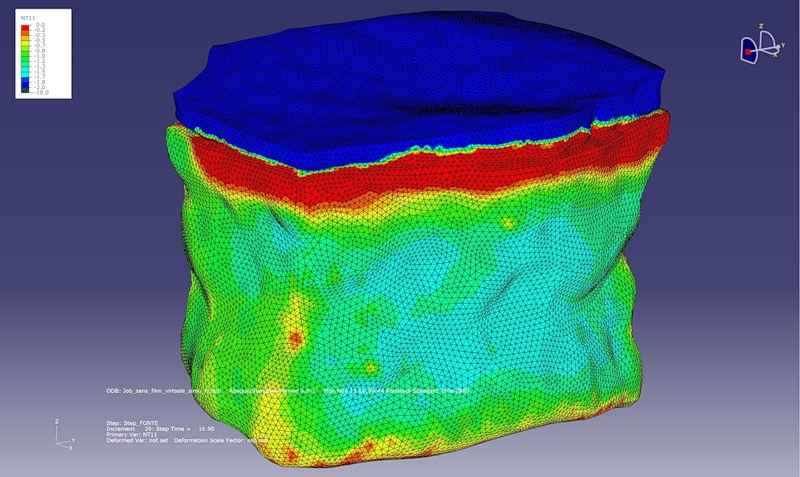
At the same time at any time of transportation you can get just such a three-dimensional projection of the iceberg, with an indication of temperature.
This video shows an example of the work of the program SIMULIA: the results of complex calculations are demonstrated in "natural conditions"
At the main office of Dassault Systemes there is a special 3D-room, where the result of the work of many people can, as they say, “feel”. It provides not only a realistic image with a 3D projector and special glasses. The picture can be controlled by “moving” in the virtual space.
Let's return to the question asked at the very beginning of the article. Is it possible to use 3D technologies not for entertainment purposes, but for serious tasks? Dassault Systemes offers his answer.
On the one hand, such visualization may seem unnecessary. On the other hand, a realistic representation of the virtual world helps in solving at least two serious problems. The first, and rather obvious: the presentation of an accurately designed project in such a way as if the journey with an iceberg had already taken place - this is the most realistic way to get funding. The second problem also lies on the surface. It is possible to calculate thousands of parameters with maximum accuracy, to create the most realistic theory, but it will never compare with the real experience of a specialist. Georges Mougins is just such a man, he has organized all his life expeditions to Antarctica, and his experience can seriously help the project. You can show him kilometers of numbers, but in some cases it is more useful to see how it actually happens: with real waves, a real tug and a real iceberg. Or as close as possible to reality.

Previously, Dassault Systemes had already participated in a similar project: it helped to prove the theory of the construction of the pyramid of Cheops using the construction of an accurate 3D model. In that case there was no guarantee that the theory would be confirmed, just as in the Iceberg project no one promises to turn the idea into reality. It can only be said with confidence that the real numbers obtained during the three-dimensional modeling of the task will increase the probability of such an embodiment. In short, the results of the work are as follows:
• Transportation of an iceberg weighing 7 million tons to the Canary Islands will take 141 days
• During this time, an iceberg will lose 38% of its original weight.
• Optimum towing speed - 1.8 km / h. The question of achieving optimal fuel consumption when towing at low speeds remains open. It is possible to use a larger number of tugboats, but initially it was decided to calculate the variant with minimal fuel consumption.
The project is not finished yet, Georges Mougins, his team and Dassault Systemes specialists continue research. Mougins has plans to further use the iceberg "in place." A huge mass of frozen water can be used for air conditioning systems, and even for the production of electricity. A film about the Iceberg project will be released soon. Movie trailer can be viewed here . You can read more about the project in a special section of the Dassault Systemes website. On this page of the site you can download the images used in the article in high resolution.
Source: https://habr.com/ru/post/117823/
All Articles